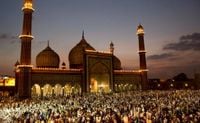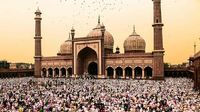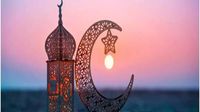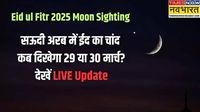The anticipation surrounding Eid-ul-Fitr 2025 is palpable as the holy month of Ramadan draws to a close. Muslims across the globe are eagerly awaiting the sighting of the moon, which will determine the exact date of this significant festival. This year, Eid is likely to be celebrated on either March 31 or April 1, depending on the lunar sighting. The festival, which symbolizes joy, unity, and gratitude, is a time for family gatherings, charitable giving, and communal prayers.
According to reports, Ramadan began on March 2, 2025, in India, following the sighting of the new moon on March 1. In Saudi Arabia, however, Ramadan commenced a day earlier, on March 1. This discrepancy means that while Eid is expected to be celebrated on March 31 in India, it could fall on March 30 in Saudi Arabia if the moon is sighted on the evening of March 29. If the moon is not visible on that date, Eid will be observed on the following day in both regions.
The significance of moon sighting in determining Eid dates cannot be overstated. The Islamic calendar is lunar-based, with each month beginning upon the sighting of the new moon. For Eid-ul-Fitr, which marks the end of Ramadan, the first day of Shawwal is celebrated as a day of festivity and gratitude. Muslims around the world celebrate this occasion with special prayers, festive meals, and acts of charity.
In Saudi Arabia, astronomers have predicted that the Shawwal moon may be visible on the evening of March 29, with expectations that it will be seen shortly after sunset. However, some experts caution that visibility may be challenging, even with telescopes. If the moon is sighted, Eid will be celebrated on March 30; if not, the celebration will shift to March 31.
As the excitement builds, the question arises: will Muslims in India and South Asia follow the moon sighting of Saudi Arabia or wait for their own local sightings? This decision can affect when families gather to celebrate, as many prefer to align their festivities with the Saudi announcement.
The festival of Eid-ul-Fitr is not just about the moon sighting; it embodies the spirit of giving and community. On this day, Muslims are encouraged to give Zakat, a form of charity, to those in need, ensuring that everyone can partake in the joy of the celebration. Additionally, children receive Eidi, a special gift or money, which adds to the festive atmosphere.
Traditionally, Eid begins with a special prayer service held in mosques and open fields, known as Eidgahs. After the prayers, families come together to share meals featuring sweet dishes like Sewaiyan (vermicelli), Firni (rice pudding), and Khurma (a sweet dish made with milk and dates). The day is marked by wearing new clothes, visiting friends and family, and exchanging greetings of "Eid Mubarak!"
The night before Eid, often referred to as Chand Raat, is a bustling time filled with shopping for new clothes, sweets, and gifts. Markets are lively, and the air is filled with the aroma of festive dishes being prepared at home.
In various countries, the duration of the holiday varies. For instance, in the UAE, if Ramadan lasts for 29 days, a three-day holiday is anticipated from March 30 to April 3. Conversely, if the month extends to 30 days, the holiday could extend to four days. Similar patterns are expected in Saudi Arabia, where a four-day holiday is likely from March 30 to April 2.
In Kuwait, the holiday structure changes based on the date of Eid; if Eid falls on March 30, a three-day holiday is expected, while a nine-day holiday will be granted if it is celebrated on March 31.
As the day approaches, many Muslims worldwide reflect on the significance of Ramadan, a month dedicated to fasting, prayer, and self-reflection. Eid-ul-Fitr, meaning "the festival of breaking the fast," serves as a culmination of this spiritual journey, celebrating the values of compassion, community, and gratitude.
In conclusion, as the moon sighting date approaches, families and communities will be on the lookout for the crescent moon that heralds the joyous occasion of Eid-ul-Fitr. Whether celebrated on March 31 or April 1, the festival promises to be a time of unity, reflection, and joy for Muslims around the world.







